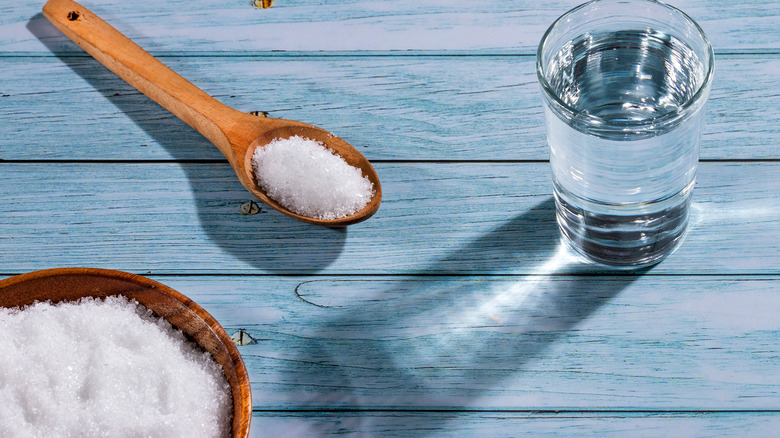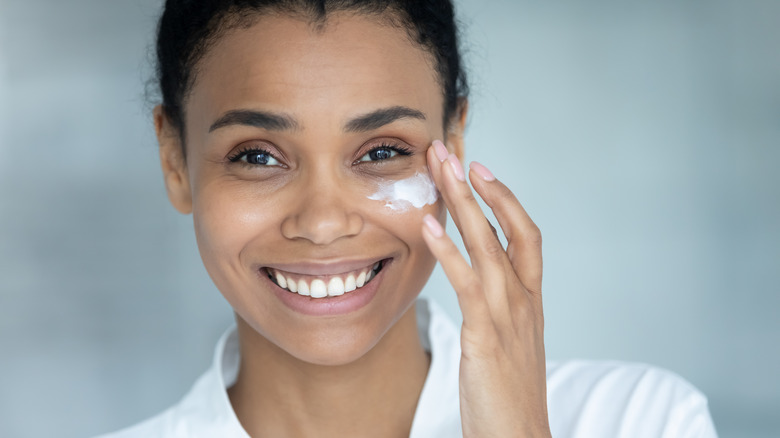Can You Use Epsom Salt To Exfoliate?
Skincare is something we should all focus on but often neglect. To really keep your complexion looking its best and your skin its healthiest, many skincare experts recommend a three-day skin cycling sequence that starts with a night of exfoliation before bed, followed by a night of applying retinol, and then two days of rest to let your face recover. That first step is especially important; according to WebMD, exfoliating removes the dead skin cells on the surface of your face or body, which not only improves your skin's appearance but also preps it for the repairing and anti-aging ingredients in the cream the next day.
Exfoliating typically involves using a mildly rough material to loosen the dead skin without damaging the sensitive layer underneath. Some OTC products use chemicals like hydroxy acids to do the job, while others have natural ingredients such as ground apricot pits, nut shells, or even sugar. But what about an ingredient you probably already have: Epsom salt? The gritty (and non-edible) salt is a staple in many bathrooms as a home remedy for minor muscle strains and bruises, but it's not usually associated with a beauty routine. So, can it do double duty as an exfoliating scrub, or is it better kept under the sink for medical purposes?
Epsom salts have healing qualities
Named after the town in England where it was first discovered in the local springs, Epsom salt is made up of magnesium and sulfate, per the Cleveland Clinic. Unlike the popular calcium chloride compound we know as table salt, Epsom salt isn't a savory condiment. However, it's been touted through the ages as a natural healer when dissolved in warm water as a soak. The salt breaks down into its separate components, and it's thought that the magnesium aids in relieving a number of ailments, from arthritis to ingrown nails to sunburn and tired feet.
While the benefits aren't proven by medical science — some doctors doubt that enough magnesium is absorbed into the body to make a difference — there's generally no harm in an Epsom salt soak. Sometimes just being in a warm tub can be beneficial when you're feeling sore and achy. And yes, it can even be used as a natural exfoliant. Epsom salt grains are large and coarse, similar to kosher salt, which makes them the proper texture to help remove dead skin cells as a scrub or made into a face-refreshing steam treatment. It also dissolves easily, making it easy to rinse off once you've finished scrubbing. You don't need to go to a pricey NYC salon for a celebrity-endorsed facial to get great results when you can get the same results with Epsom salts for a fraction of the cost. (A 3-pound bag will set you back about $5.)
How to use Epsom salt on your face
If you're curious about trying an Epsom salt face scrub, it's as easy as picking up a bag of the salts at your neighborhood supermarket or drugstore, along with a jar of your preferred cleansing cream. Prevention recommends mixing between one-half and one teaspoon of the salt with the cream, then rubbing it gently onto your face in a circular motion. Rinse with warm water and pat dry. The Epsom Salt Council has an alternative recipe: one tablespoon each of Epsom salt, honey, and olive oil, plus a few drops of lemon juice. Mix together, apply to your face, and let it sit for up to 10 minutes before washing it off with warm water (in the shower is best). Dry gently, then apply moisturizer.
But why stop at your face? You can use Epsom salt as a whole-body scrub. Combine half a cup of the salt in a bowl with a half cup of a natural oil, such as coconut or almond oil. If you like, add a few drops of an essential oil such as lavender or mint (via Chas Crazy Creations). In the shower, dampen your skin, then apply the scrub all over. You can also use Epsom salts as a pore-opening steam, per Allure. Add a teaspoon or two of the salt to a small bowl of hot water, then hold the bowl under your face and let the steam do its work. Follow up with your favorite face mask.


